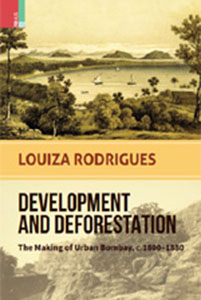
Development and Deforestation: The Making of Urban Bombay, c.1800-1880
AUTHOR- Louiza Rodrigues
| HB ₹995 . $49.95 . ₤39.95 |
||
INFORMATION
- AUTHOR : Louiza Rodrigues
- ISBN : 978-93-5290-342-9
- Year : 2019
- Extent : 276
- Discount available on checkout
- Usually dispatched within 3 to 5 working days.
Rabindranath Tagore
| HB ₹ 1350 . $ . ₤ |
PB ₹ . $ . ₤ |
|
| POD ₹ . $ . ₤ |
e-Book ₹ . $ . ₤ |
INFORMATION
- AUTHOR –
- ISBN – 978-93-84082-82-6
- Year – 2016
- Extent: 400 + 40 coloured illustrations
- 10% discount + free shipping
- Usually dispatched within 3 to 5 working days.
Based upon an in-depth empirical research, Development and Deforestation: Making of Urban Bombay studies the green dense in scaling the urbanization of Bombay in the nineteenth century. In particular, the book traces the principal consequences of the political intervention of the British in reshaping the ecological landscape of western India. In metamorphosing political intervention into the colonial control, the British botanists, conservators and military engineers undertook scores of forest surveys. Most significantly, timber trade dynamics were constructively utilized, which, regrettably resulted in a massive deforestation of western India. Such correlations between timbered commodity and urbanization, leading to subsequent deforestation are understudied. This book underscores the colonial psyche in articulating conservation policies and uncovers strategies that have been overlooked in the literature on the Environmental history of the Bombay Presidency. Drawing on rich archival sources and some significant secondary literature, this book traces the history of citified infrastructural developments in building warships, houses, bungalows, public buildings, railways and in the manufacturing of furniture in Bombay and the Bombay Presidency that eventually triggered urbanization. Correspondingly, the subject of deforestation of western India in three distinctive phases and ensuing afforestation, which fed the needs of the empire, is also highlighted.
The Author
Louiza Rodrigues is Professor and Head in the Department of History, Ramnarain Ruia College, Mumbai. Her area of specialization is Environmental History, Urban History, Genealogy and Modern India. She has to her credit major research projects from the K.R. Cama Oriental Institute of Mumbai, Asiatic Society of Mumbai, Mumbai University and Exeter University for Gulf Studies, UK. She has published more than 25 research papers and articles in books and journals of national and international repute. She is the leading author of two books on the history of the Seth and Sethna families, and, has recently published a monograph on Philip Anderson (1816-57).
This volume explores the multifaceted genius of Rabindranath Tagore in rescuing the stagnant cultural life of Bengal from its many inhibitions. He was an ardent supporter of women’s participation in dance and drama. He was a precursor of Indian abstract art. In education, he was heavily influenced by the New School Movement, teaching young children to live in harmony with nature. His works often explore the relationship between human experience, and the landscape and atmosphere and he mobilized the energy of his dedicated children (bratibalakas and bratibalikas) for rural resuscitation. A bitter critic of the aggressive nationalism of the West, he acted as a cultural mascot for the ‘submerged nationalities’ of war-ravaged East Europe. In this collection of essays, our contributors explore the works and legacy of a man much ahead of his time.
The Editor
Chhanda Chatterjee is Professor and Director, Centre for Guru Nanak Dev Studies, and Programme Coordinator, UGC SAP DRS II of the Department of History at Visva-Bharati, Santiniketan, West Bengal. Her publications include Ecology, the Sikh Legacy and the Raj Punjab, 1849-1887 (1997), Ideology, the Rural Power Structure and Imperial Rule: Awadh and Punjab, 1858-1887 (1999), and Literature as History: From Early to Contemporary Times (2014).
Table of Contents
| Acknowledgements | Vii-Viii |
| Introduction | 1-15 |
| 1. Ecology Of Western India | 16-30 |
| 2. Shipbuilding In Bombay: Impact On The Forests Of Western India, C.1800-1838 | 31-81 |
| 3. Public Buildings, Private Housing, And Furniture: Extraction Of Timber Resources Of Western India | 82-123 |
| 4. Forest Conservation In Bombay Presidency, C.1839-1860 | 124-164 |
| 5. Railways In The Bombay Presidency: Deforestation And Afforestation In Western India 165-229 | 230-236 |
| Conclusion | 236-242 |
| Appendices | 243-257 |
| Bibliography | 259-267 |




